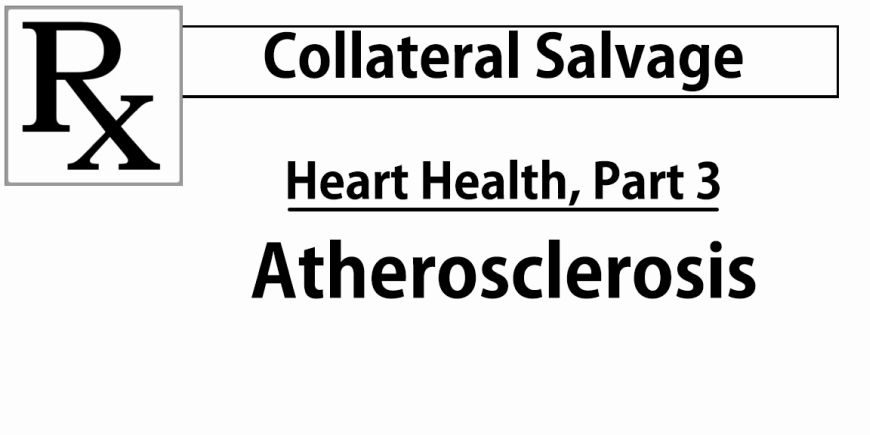So far we’ve talked about cholesterol and blood pressure, both of which are indicators of heart health. If either of them are too high, it’s indicative of an issue we need to resolve. Today, we’re going to talk about one of the underlying causes of cardiovascular disease (CVD).
First, science.
Atherosclerosis is the accumulation of fatty plaques in our arteries and veins. Its name comes from the Greek words athera (gruel or wax) and sklerosis (hardening). Atherosclerosis has been a problem for humans for at least 3,500 years; evidence of arterial plaque build-up has been found on Egyptian mummies.

The genesis of atherosclerosis is not completely understood. What we do know begins with damage to the interior of the arterial walls, known as the endothelium. Specialized white blood cells, known as monocytes, enter the damaged endothelium where they transform into a macrophage, another type of white blood cell that specializes in clearing debris from the body. These macrophages consume cholesterol-laden low-density lipoprotein (LDL) molocules, becoming fatty streaks on the arterial walls. This begins in childhood through early adolescence.
This process continues through our adolescent and adult life. These fatty streaks accumulate under the endothelium and become necrotic (composed of dead cells) and covered with a fibrous shell. The body responds to this by locally enlarging the affected artery but there is a limit to this expansion. Calcium deposits begin to accumulate between the muscular interior of the arterial wall and the plaque deposit, stiffening the arteries. This stage of the disease is known as fibroatheroma and it begins in our teenage years.

After the age of 55 the risk of fibroatheroma is greatly increased. The fibrous caps of our arterial plaques become thin and are more likely to rupture. When that happens it exposes the artery to the necrotic core of the plaque which provokes a clotting response from our blood. A blood clot forming in a blood vessel (thrombosis) can clog our arteries (embolism), cutting off blood supply to our brain (stroke), heart (heart attack), limbs (ischemia), or other organs. If we are lucky enough to avoid these risks, the accumulation of plaque will eventually block the flow of blood to such a degree that it will lead to our death.
What can we do about it?
First we need to know what we’re up against. Unfortunately the most popular way to see the extent of plaque built-up in our blood vessels is via a technique known as angiography. A traditional angiography requires a surgery where a catheter is placed in our femoral artery and our blood is dyed with a liquid to make it show up on x-rays. Cost: ~$5,000. It’s also possible to use a technique called computed tomography angiography (CTA) that doesn’t require surgery. Cost: ~$800.

The problem with angiography is that it can only detect when a blood vessel has been constricted. Many plaque ruptures occur in arteries with no constriction, so angiography is only for very serious cardiac issues. Other techniques are available that offer a better picture but they require invasive surgery as well. Cost: ~$1,000.
The most accessible diagnosis for most people is going to be the cardiac stress test. Cost: ~$200. However, this type of testing can only identify later-stage atherosclerosis in which the blood vessels are already occluded.
As far as treatment goes, the best treatment is prevention: eat healthy (as we’ve already talked about), exercise, maintain a healthy body weight, and don’t smoke. These simple lifestyle choices will prevent up to 90% of CVD. They’re also effective at treating atherosclerosis so it’s never too late to start making these changes.

There are also drugs available that have been shown to reduce plaque levels in our blood vessels. Statins are the most popular and generally have mild side effects. Niacin is also a potential treatment for atherosclerosis. Both drugs seem to provide a benefit even after they aren’t being taken, which suggests that they are treating an underlying issue, and not just a symptom.
Heart disease is the number one cause of death in the world. The annual cost of heart disease is estimated to be around $10 billion. Individual costs can range from $10,000 – $200,000 for hospitalization due to CVD. The choices we make now will save our bank account — and our lives — in the future.
